The more time passes, the more nostalgic I get with old hardware. Video cards and motherboards tend to be my weak spot. As such, I often scavenge eBay for old PC hardware, especially anything with bad caps or in need of similar minor repair.
For today's consideration, I have a popular low-end card from back in the early 2000's: an nVidia GeForce FX5200. This one is the BFG Tech. Asylum take on the card, with 256 MB of DDR RAM running at 400 MHz and 128-bit bus (vs. 64-128 MB and 64-bit bus on many of the cheaper versions.)
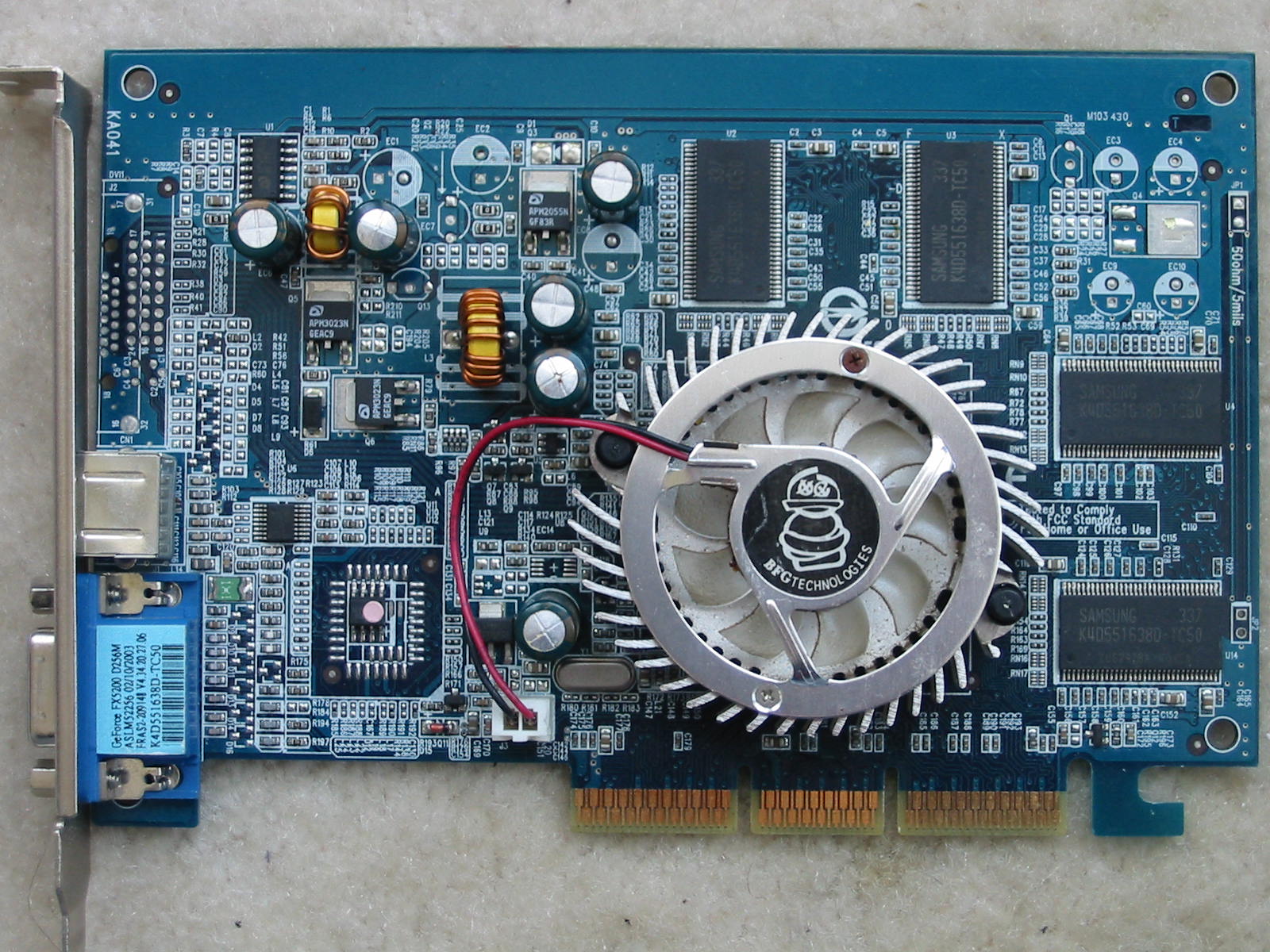
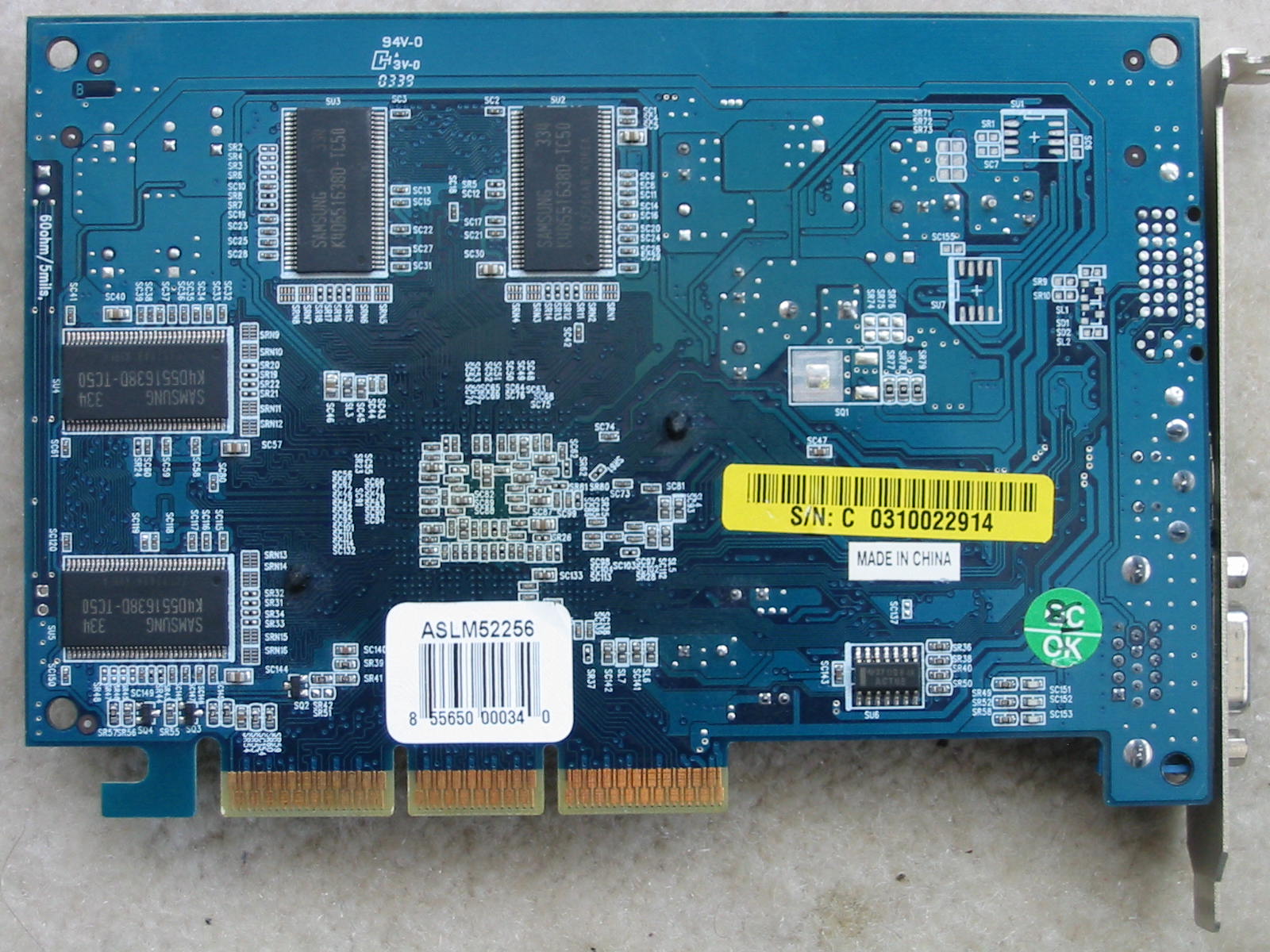
I think it's easy to see what's wrong with this card. Bad caps are one of my favorite problems on old hardware, as this is usually all that's wrong. Although FX5200 cards are hardly worth new caps (given their performance), I still found it absolutely worth it for the fun of getting old hardware fixed. At $10 total for the card (including getting it shipped to my door), why not, right?
Bad caps are one of my favorite problems on old hardware, as this is usually all that's wrong. Although FX5200 cards are hardly worth new caps (given their performance), I still found it absolutely worth it for the fun of getting old hardware fixed. At $10 total for the card (including getting it shipped to my door), why not, right? 
The card came exactly as pictured… but no mention in the auction that the fan on the cooler was also bad.
https://www.badcaps.net/forum/attach...1&d=1565539312
Not that I'd cry about another dead 40 mm fan, as those things are too loud anyways. What worried me is that the card looked overheated on the back of the GPU area, probably due to the fan seizing. Nevertheless, I crossed my fingers and started working on the recap.
First step (for me, anyways), is identify the various rails on the card. I like doing this and making a little reference sheet, so that I can decide what caps to use (I rarely use identical spec caps on video cards, unless I happen to have them.)
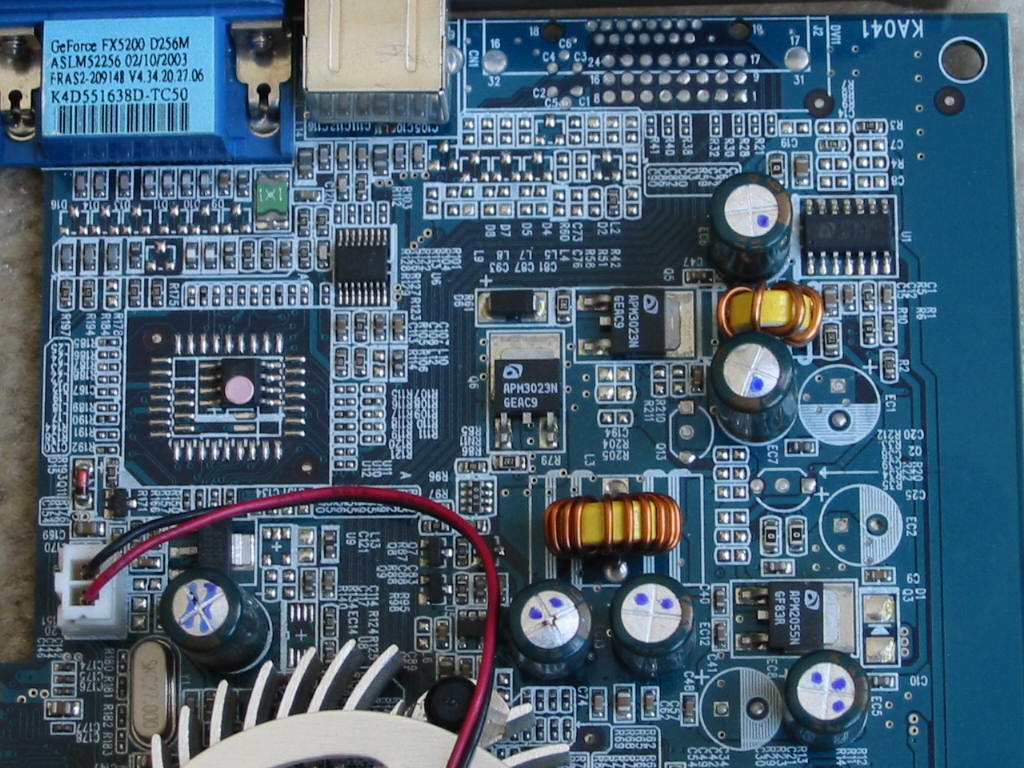
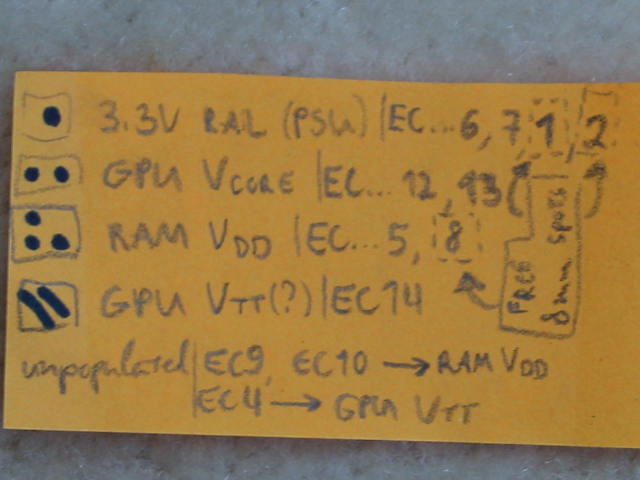
For those who can't log in and view the pictures, here is the text version:
Electrolytic caps in spots EC6, EC7, EC1**, and EC2** ---> 3.3V rail from PSU
Electrolytic caps in spots EC12 and EC13 ---> GPU V_core
Electrolytic caps in spots EC5, EC8**, EC9**, and EC10** ---> RAM V_ddr (2.5V)
Electrolytic caps in spots EC14 and EC4** ---> GPU V_tt
** ---> free / empty cap spots that can be populated, if desired
Note: since most rails are 3.3V or less, 6.3V caps will be absolutely fine to use for the entire card. In fact, even 4V (polymer) caps could be used on some of the rails – though I personally don't recommend using polymers on this card, as there won't be any benefit. If you do, only do the GPU V_core rail, as that is a buck-type regulator. RAM V_ddr and GPU V_tt are linearly generated, so ultra-low ESR caps are not needed at all and, in fact, may be an issue (I didn't try, so I don't know – consider it experimental if you do that.) Unlikely. But I still don't recommend it.
Speaking of caps and what to use… I did a test recap first (again, due to card looking overheated) with a bunch of OST RLP 6.3V, 1000 uF caps I pulled from a board that already had many of these same ones bad (the few I used were tested good on my ESR meter.) Mixed those with a few new Rubycon ZLH 6.3V, 820 uF caps to keep the ESR low (particularly on the GPU V_core.) And just for testing, I used a fan from another video card I bought and modded around the same time (a GeForce 7300 GT AGP version). So here is the temporary recap with the temporarily-fixed cooler:
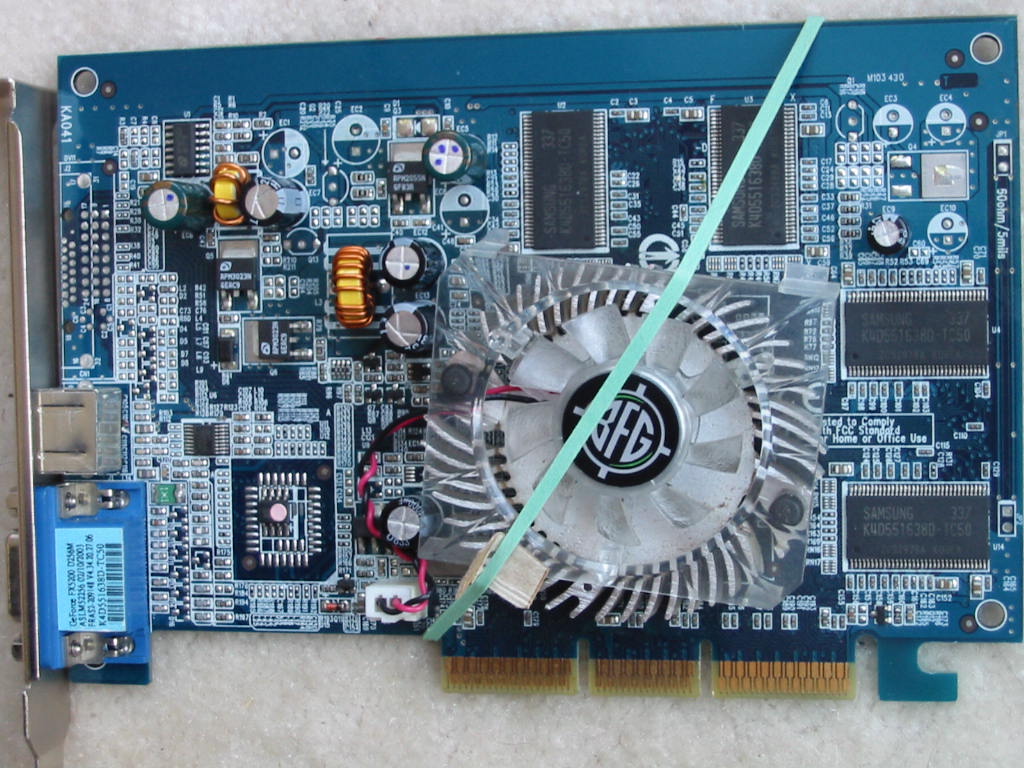
Ugly – yes! But it worked for a full test just fine. As such, I opted to do a more proper recap. Again, it may not seem worth it on such an old and slow card. Considering that this card survived all these years (including with the seized fan), however, I think it has already proven itself that it deserves a second chance at life.
As such, I opted to do a more proper recap. Again, it may not seem worth it on such an old and slow card. Considering that this card survived all these years (including with the seized fan), however, I think it has already proven itself that it deserves a second chance at life. 
So… step 2: removed old cooler and recap:
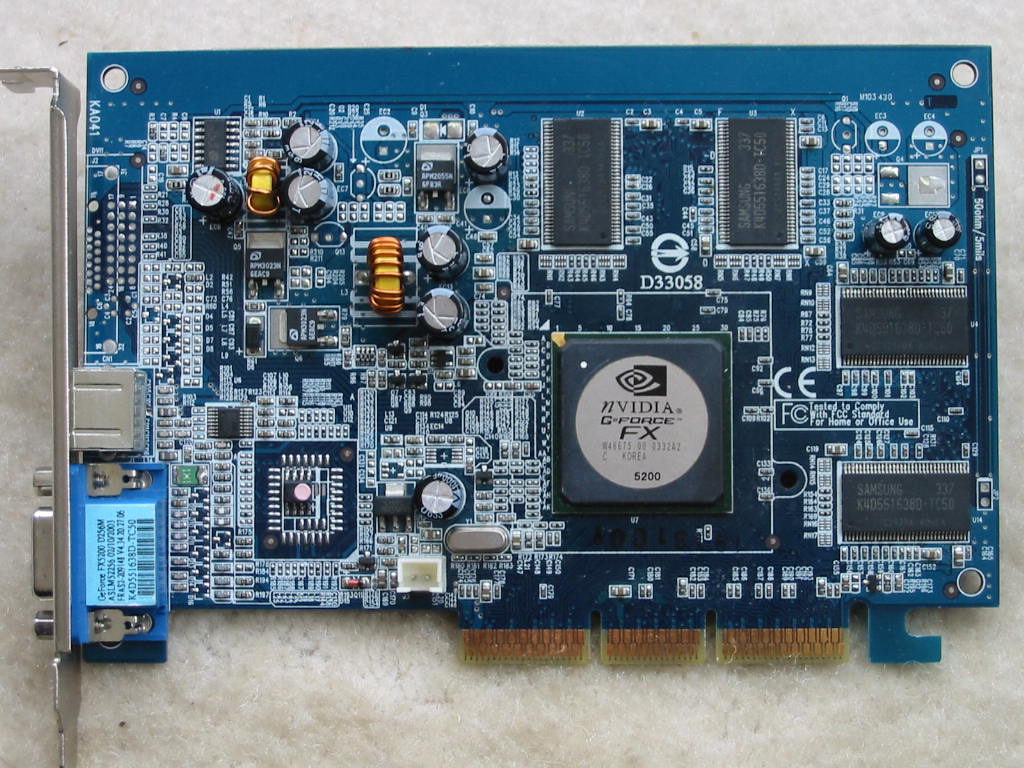
Here is the old HS without the fan:
https://www.badcaps.net/forum/attach...1&d=1565539312
And here is what I came up with (again) to replace that original cooler:
https://www.badcaps.net/forum/attach...1&d=1565539312
It's an Xbox 360 GPU rev1 heatsink, but with a few cuts and trims to make it fit on the board.
The recapped and modded video card:
https://www.badcaps.net/forum/attach...1&d=1565539312
I didn't stop there, of course. Despite the fact that the above modded heatsink can probably cool the FX5200 GPU passively, I still attached a small 50 mm fan.
Despite the fact that the above modded heatsink can probably cool the FX5200 GPU passively, I still attached a small 50 mm fan.
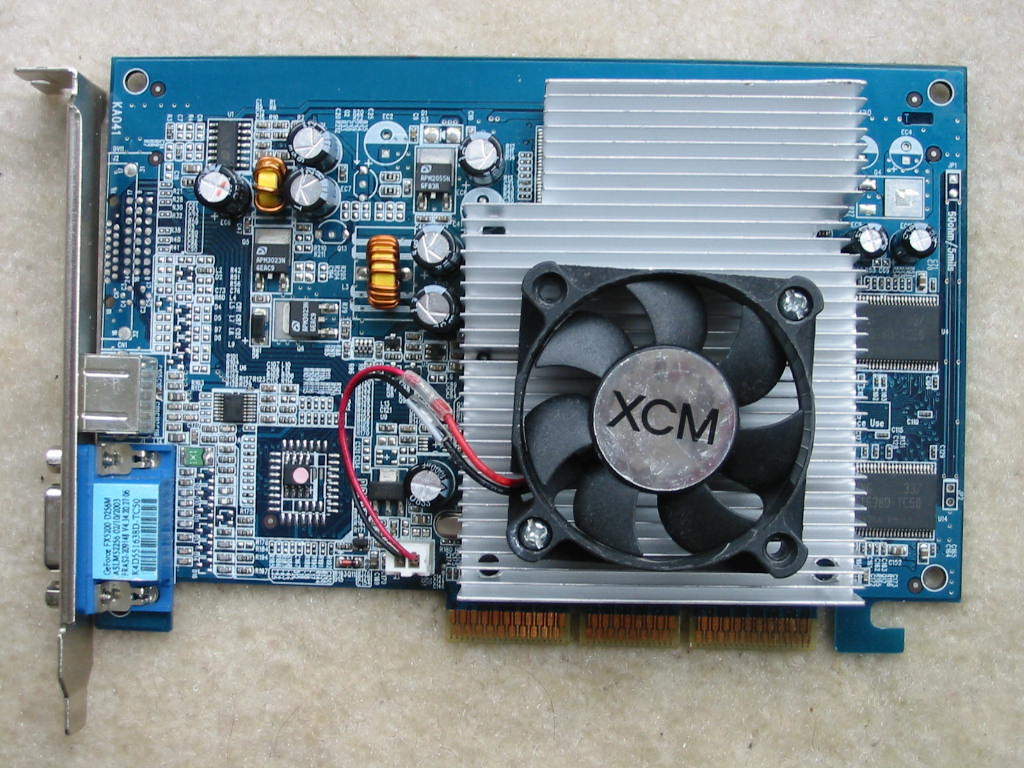
To make the fan more quiet, I rewired the fan connector to supply only 7V to the fan, I did this by removing Q11 and adding a wire between the fan connector's ground/black (-) lead and a 5V rail point on the board.
https://www.badcaps.net/forum/attach...1&d=1565540075
So now, the fan essentially runs on 7V (difference between PSU's 12V and 5V rails.)
And that is all for this video card recap, really. The whole card runs very cool to the touch, even at ~30°C / 86°F room temperatures.
For today's consideration, I have a popular low-end card from back in the early 2000's: an nVidia GeForce FX5200. This one is the BFG Tech. Asylum take on the card, with 256 MB of DDR RAM running at 400 MHz and 128-bit bus (vs. 64-128 MB and 64-bit bus on many of the cheaper versions.)
I think it's easy to see what's wrong with this card.
 Bad caps are one of my favorite problems on old hardware, as this is usually all that's wrong. Although FX5200 cards are hardly worth new caps (given their performance), I still found it absolutely worth it for the fun of getting old hardware fixed. At $10 total for the card (including getting it shipped to my door), why not, right?
Bad caps are one of my favorite problems on old hardware, as this is usually all that's wrong. Although FX5200 cards are hardly worth new caps (given their performance), I still found it absolutely worth it for the fun of getting old hardware fixed. At $10 total for the card (including getting it shipped to my door), why not, right? The card came exactly as pictured… but no mention in the auction that the fan on the cooler was also bad.
https://www.badcaps.net/forum/attach...1&d=1565539312
Not that I'd cry about another dead 40 mm fan, as those things are too loud anyways. What worried me is that the card looked overheated on the back of the GPU area, probably due to the fan seizing. Nevertheless, I crossed my fingers and started working on the recap.
First step (for me, anyways), is identify the various rails on the card. I like doing this and making a little reference sheet, so that I can decide what caps to use (I rarely use identical spec caps on video cards, unless I happen to have them.)
For those who can't log in and view the pictures, here is the text version:
Electrolytic caps in spots EC6, EC7, EC1**, and EC2** ---> 3.3V rail from PSU
Electrolytic caps in spots EC12 and EC13 ---> GPU V_core
Electrolytic caps in spots EC5, EC8**, EC9**, and EC10** ---> RAM V_ddr (2.5V)
Electrolytic caps in spots EC14 and EC4** ---> GPU V_tt
** ---> free / empty cap spots that can be populated, if desired
Note: since most rails are 3.3V or less, 6.3V caps will be absolutely fine to use for the entire card. In fact, even 4V (polymer) caps could be used on some of the rails – though I personally don't recommend using polymers on this card, as there won't be any benefit. If you do, only do the GPU V_core rail, as that is a buck-type regulator. RAM V_ddr and GPU V_tt are linearly generated, so ultra-low ESR caps are not needed at all and, in fact, may be an issue (I didn't try, so I don't know – consider it experimental if you do that.) Unlikely. But I still don't recommend it.
Speaking of caps and what to use… I did a test recap first (again, due to card looking overheated) with a bunch of OST RLP 6.3V, 1000 uF caps I pulled from a board that already had many of these same ones bad (the few I used were tested good on my ESR meter.) Mixed those with a few new Rubycon ZLH 6.3V, 820 uF caps to keep the ESR low (particularly on the GPU V_core.) And just for testing, I used a fan from another video card I bought and modded around the same time (a GeForce 7300 GT AGP version). So here is the temporary recap with the temporarily-fixed cooler:
Ugly – yes! But it worked for a full test just fine.
 As such, I opted to do a more proper recap. Again, it may not seem worth it on such an old and slow card. Considering that this card survived all these years (including with the seized fan), however, I think it has already proven itself that it deserves a second chance at life.
As such, I opted to do a more proper recap. Again, it may not seem worth it on such an old and slow card. Considering that this card survived all these years (including with the seized fan), however, I think it has already proven itself that it deserves a second chance at life. So… step 2: removed old cooler and recap:
Here is the old HS without the fan:
https://www.badcaps.net/forum/attach...1&d=1565539312
And here is what I came up with (again) to replace that original cooler:
https://www.badcaps.net/forum/attach...1&d=1565539312
It's an Xbox 360 GPU rev1 heatsink, but with a few cuts and trims to make it fit on the board.
The recapped and modded video card:
https://www.badcaps.net/forum/attach...1&d=1565539312
I didn't stop there, of course.
To make the fan more quiet, I rewired the fan connector to supply only 7V to the fan, I did this by removing Q11 and adding a wire between the fan connector's ground/black (-) lead and a 5V rail point on the board.
https://www.badcaps.net/forum/attach...1&d=1565540075
So now, the fan essentially runs on 7V (difference between PSU's 12V and 5V rails.)
And that is all for this video card recap, really. The whole card runs very cool to the touch, even at ~30°C / 86°F room temperatures.
 Whichever the case, it's still an NV34 GPU running at the correct core and memory clocks for the FX5200.
Whichever the case, it's still an NV34 GPU running at the correct core and memory clocks for the FX5200.
 Although my card is noticeably better than the 64-bit variants (I also have an MSI FX5200 with 128 MB of RAM and 64-bit bus, which I got in a pack of other eBay cards a while back), this doesn’t say much.
Although my card is noticeably better than the 64-bit variants (I also have an MSI FX5200 with 128 MB of RAM and 64-bit bus, which I got in a pack of other eBay cards a while back), this doesn’t say much. ) and maybe NFS Porsche Unleashed and High Stakes (both of which run OK even on Intel Extreme Graphics 2 / i865 IGP, if that is to tell you anything
) and maybe NFS Porsche Unleashed and High Stakes (both of which run OK even on Intel Extreme Graphics 2 / i865 IGP, if that is to tell you anything
Comment